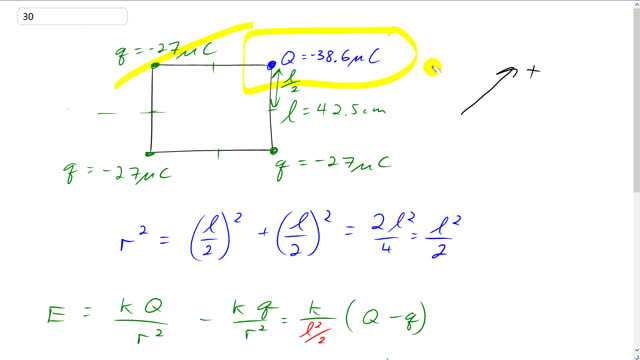
Calculate the electric field at the center of a square 42.5 cm on a side if one corner is occupied by a charge and the other three are occupied by charges.

In order to watch this solution you need to have a subscription.
This is Giancoli Answers with Mr. Dychko. We have a square with charges of negative 27 micro coulombs at three corners and a charge of negative 38.6 micro coulombs at one of the corners. And we have to find the electric field in the middle of the square. So first of all we can notice that this charge and this charge will result in electric fields in the opposite directions with equal magnitudes. And so they'll cancel. And so these charges don't matter at all. And we can just ignore them. And so our only work then is to consider how these two electric fields due to these two charges combined. So we'll take positive to be towards this charge and this charge is going to have an electric field directed towards it like this. Because if you put a positive test charge there it would be attracted to this negative charge. And this charge will also have an electric field at the center directed towards it slightly shorter because it's a smaller charge and equal distance compared to this charge. And we need to know what this distance r is that goes from the center to the corner and this distance is going to be the same for both these charges to the center because it's a square. And so this this triangle here has side length l over two. The side length of the square divided by two. And so we can figure out are by going r squared is l over two squared, l over two squared. That's Pythagoras which is two times l squared over four and I mean if you take this square, it makes l squared over four and then there's two of them. So that's two l squared over four which makes l squared over two in the end. And the electric field at this point is going to have two terms. It'll have the term due to this charge capital Q which is k Q over the distance squared and that's going to be positive because we're taking positive to be towards that blue charge and then minus k q over r squared and that's minus because we're taking this direction to be negative and we're taking care of… we're just plugging in magnitudes of charge here by the way and we're taking care of negative signs separately. So this has a minus and this is plus based on the directions that we can see. And we can factor out the k over r squared and then also substitute l squared over two in place of r squared. And this makes k over l squared over two times capital Q minus little q which is, multiply top and bottom by two, two cancel in the bottom leaving us with the two on top. We have two k over l squared times capital Q minus little q. So that’s two times 8.988 times ten to the nine newtons meter squared per coulombs squared divided by 42.5 times ten to the minus two meters squared, that's the side links of the square, and then times by 38.6 times ten to the minus six coulombs minus 27 times ten to the minus six coulombs and we get 1.15 times ten to the six Newtons per coulombs, towards the negative 38.6 micro coulomb charge.
Hi Professor Dychko,
I'm confused on why you would not solve for the x and y components of both electric fields and then take the magnitude of the net electric field.
Thanks!
Hi Professor Dychko,
I'm confused on why you would not solve for the x and y components of both electric fields and then take the magnitude of the net electric field.
Thanks!